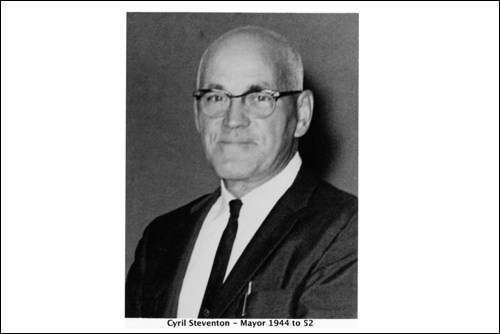As Flin Flon braced for a post-Second World War population explosion, residents required forward-looking leadership.
They found it in a middle-aged Englishman named Cyril Steventon – one of the most consequential mayors in the community’s history.
“He looked after the city of Flin Flon very well,” recalls Bob Barr, a former Flin Flonner who knew Steventon. “He was, I would say, a pretty fair guy. He assessed things well.”
Steventon oversaw a massive expansion of population and municipal services during a then-unprecedented nine-year run as mayor between 1944 and 1952.
Chief among his signature projects was a $1.32-million extension of sewer and water services to 1,350 lots in the Willowvale, Callinan, Ross Lake, Hapnot, Mile 84 and Birchview subdivisions. The project enjoyed unprecedented support, garnering a 97 per cent backing in a public vote.
Steventon’s administration was the first to secure an annual grant from Hudson Bay Mining and Smelting Co., Ltd (HBM&S), now part of Hudbay. The initial grant of $25,000 – $356,900 in today’s dollars – funded civic improvements.
Under Steventon, the town also annexed land in Saskatchewan, moved the RCMP into a new federal building and witnessed the long-awaited arrival of a highway connection to the rest of the province.
Steventon achieved all of this while creating seemingly little friction with his councillors.
“I never heard any councillor ever complain about him while he was mayor, and over the years I crossed paths with a lot of those councillors during my employment and also during my recreation,” says Barr.
Transfer
Steventon was born in Birmingham, England on August 31, 1900. Boyishly handsome and bespectacled, he joined the Winnipeg office of HBM&S in either the 1920s or 1930.
In September 1930, days after his 30th birthday, he arrived in Flin Flon, having transferred to the company’s mechanical department.
Steventon became involved in the fledgling community, serving as an executive member, auditor and trustee with Royal Canadian Legion Branch No. 73. In 1934, he married a nurse from The Pas who would give birth to their three children.
By 1938, Steventon was ready to take a shot at civic politics. He ran for town council and won a seat he would occupy for the next six years.
While Steventon was respected as a civic leader, he was not necessarily of the warm and fuzzy variety.
“I never did see a big sense of humour in him, let’s put it that way. He was very businesslike,” says Barr.
“[Steventon’s son] Jack was a very happy-go-lucky guy, but he didn’t get it from his father.”
As a councillor, Steventon served under three mayors before deciding he was ready for the top job himself. In his first mayoral campaign, he defeated incumbent mayor O.F. Wright to assume office in 1944.
Steventon’s approach as mayor marked a departure from that of the more conservative Wright. As the book Flin Flon describes: “Once [Steventon] became firmly entrenched in the mayor’s chair, the hold-the-line policies of O.F. Wright, the former mayor, were abandoned in favour of progressive development of the municipal district of Flin Flon.”
Of course Steventon may not have had much choice. At the height of his mayoralty, Flin Flon’s population soared by as much as 60 per cent to include 12,000 residents as of 1951. With that sort of growth, a “hold-the-line” approach may have been unrealistic.
Defeat
Steventon racked up multiple successes as mayor, but it wasn’t enough to stave off a movement for change led by colourful town councillor Jack Freedman, a fellow Englishman.
In 1952, Freedman defeated Steventon for mayor by a modest 82 votes. The cigar-chomping Freedman, known for his blackboard-scrawled messages to the citizenry, went on to become one of the community’s most popular mayors. Steventon never held office again.
As Flin Flon observed: “[Steventon] had seen the evolution of a very ‘close-knit’ mining community to a modernized town linked by highway to the southern region of the province allowing citizens to travel by automobile or to use the bus as alternatives to the common train, or occasional trip by aircraft.”
Now a private citizen, Steventon remained at HBM&S until 1965, retiring as superintendent of the mechanical and construction department.
His retirement was all too short. On November 8, 1967, Steventon, an amateur photographer, died suddenly of a heart attack while snapping photos at a fashion show. He was 67.
“Everybody was kind of shocked,” recalls Barr.
“He was a pretty well-built fellow. He took care of himself and I don’t know, he had this massive heart attack all of a sudden.”
Today Steventon’s legacy is immortalized by the Flin Flon boulevard that bears his name. Five decades after his death, he is remembered as the leader the community needed, when it needed him.




